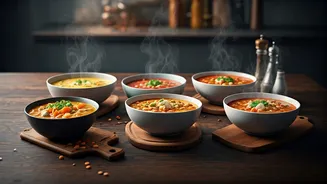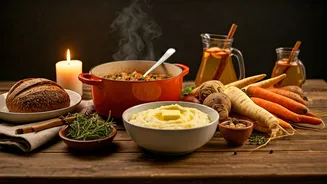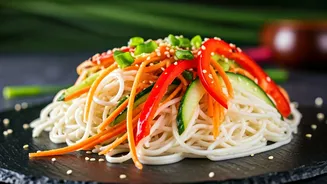Bean Basics Explained
Beans, a pantry staple across many cultures, are incredibly versatile, offering an affordable and nutritious food source. Whether you're working with dried
beans or canned varieties, their preparation varies. Dried beans require soaking, typically overnight, to reduce cooking time and improve digestibility. Soaking also helps remove some of the compounds that can cause digestive discomfort. After soaking, rinse the beans and simmer them in fresh water until tender. Canned beans, conversely, are pre-cooked, making them ready to use after rinsing to remove excess sodium. Consider the different types of beans available, such as kidney, black, pinto, and cannellini, each with unique flavors and textures suitable for various dishes. A versatile ingredient, beans can enhance salads, soups, stews, and even baked goods, adapting easily to flavor profiles and dietary preferences.
Soup & Stew Creations
Bean-based soups and stews provide both comfort and nutrition. The heartiness of beans makes them a perfect base for flavorful and filling meals. Consider a classic bean and ham soup, where the smoky ham complements the earthy beans, or a vibrant vegetable stew featuring a medley of beans alongside seasonal produce. Lentil soup, frequently prepared with green or brown lentils, often includes aromatic vegetables like carrots, celery, and onions, offering a simple yet satisfying meal. For a richer flavor, explore chili recipes, combining various types of beans with ground meat, spices, and tomatoes. The beauty of these dishes lies in their adaptability: adjust the ingredients to your preferences, making them both exciting and effortless for everyday cooking. Add spices, herbs, and other ingredients to enhance your overall dining experience.
Salads & Sides Featuring Beans
Beans add texture, protein, and flavor to a variety of salads and side dishes. A simple white bean salad with fresh herbs and a lemon vinaigrette is refreshing and easy to make. Adding black beans to a Southwestern-inspired salad, along with corn, avocado, and a zesty dressing, provides a burst of flavors and textures. For a more substantial side, consider a bean salad featuring kidney beans, green beans, and a flavorful dressing. Beans can also enhance grain-based salads, such as quinoa or couscous salads. They pair well with vegetables like bell peppers, cucumbers, and tomatoes, creating a well-balanced and nutritious dish. You can roast or pan-fry beans for a slightly crispy texture before adding them to salads, enhancing their appeal and enjoyment.
Main Dishes with Beans
Beans can be the star of many main courses. Vegetarian chili, prepared with different types of beans, vegetables, and a medley of spices, is a hearty and flavorful option. Bean burgers, made from mashed beans and seasonings, offer a meatless alternative with a satisfying texture. Consider refried beans served with tortillas and your favorite toppings for a quick and easy meal. Beans also can be combined with other proteins, like chicken or sausage, to create complete and balanced meals. For example, a slow-cooked chicken and bean stew provides a comforting meal perfect for a chilly evening. Beans also can be used in casseroles, making them an excellent choice for meal prepping and feeding a crowd.
Global Flavors and Spices
Beans are a blank canvas for diverse flavors. Explore dishes inspired by different global cuisines. For instance, a hearty Moroccan bean stew features warm spices like cumin and coriander, offering an exotic taste. In Indian cuisine, dals, made from various types of lentils and beans, are frequently seasoned with turmeric, ginger, and garlic, creating aromatic and flavorful dishes. Mexican cuisine features refried beans, chili, and bean-filled enchiladas, providing a range of hearty and flavorful options. Consider adding herbs and spices to enhance the flavors of beans. Experimenting with different cuisines will expand your culinary horizons and introduce you to new and exciting ways to cook with beans.
Tips and Tricks
To fully enjoy cooking with beans, here are some tips. Start with quality beans, either dried or canned, and always rinse canned beans to remove excess sodium. When cooking dried beans, use fresh water, and avoid adding salt until the beans are tender, as salt can sometimes harden them. Experiment with various herbs and spices to enhance the flavors. If you're looking for extra flavor, consider adding aromatics like onions, garlic, and celery when cooking. For canned beans, they can be added to dishes directly, but it is always best to rinse them first. Remember that different bean varieties have varying cooking times, so check your beans frequently while cooking. By following these tips and exploring recipes, you can create delicious and nutritious meals with beans.













